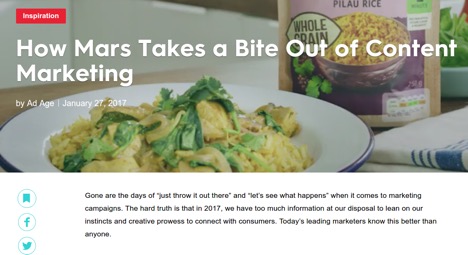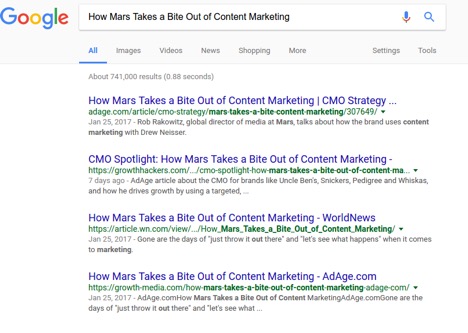- Share The Downsides of Licensed Content on Facebook
- Share The Downsides of Licensed Content on Twitter
- Share The Downsides of Licensed Content on Linkedin
- Share The Downsides of Licensed Content via email
If you’re using third party content in your content marketing strategy, you have two options: unlicensed content, and licensed content. It’s worth understanding the pros and cons of each, especially as they apply to content curation. Here’s a quick overview on each, and how to think about which is right for you.
The Unlicensed Content Model
The first and most popular option is to use unlicensed content from around the web. In this model, a content curator does not seek explicit permission from the content authors. Instead the curator, keeping the fair use statute in mind, shares a small excerpt from the original text with clear attribution back to the original article. Readers of the curated content must go to the original publisher’s site to read the article in full.
The Licensed Content Model
The second model is to license content from the original author and republish the original content in its entirety on the curator’s site. The appealing aspects of licensed content are:
- It provides a seamless reading experience.
- There’s no risk of driving readers off your site.
- You don’t have to worry about fair-use or how much content you take.
The Downsides of Curating Licensed Content
While licensed content seems attractive, there are some obvious—and not so obvious, downsides to building a destination based on this model.
-
Limited Selection. Licensed content severely limits your sources for third party content. You can only curate content from sources with whom you either have a direct publishing relationship or with whom your licensed content provider has a relationship. Most resellers of licensed content only have relationships with the largest mainstream publishers, such as the Associated Presses and Reuters of the world.
As a result, licensed content is not an option for most content marketers, who focus on specific topics and niches—particularly B2B marketers who rely on specific trade publishers and blogs.
-
Search Engine Optimization (SEO). Publishers can’t have their original articles confused with duplicate content. So they contractually obligate those licensing their content to include special directives forbidding search engines from indexing the copies. As a marketer, this means licensed content on your site has little to no SEO value.
For brands looking to simply engage their existing audience and provide a more seamless reading experience, licensed content may be the right option. But most marketers don’t just want to engage their existing audience. They want to grow their audience through search engine traffic. For such marketers, licensed content is not a compelling option.
Some licensed content providers no longer include noindex directives, allowing search engines to index syndicated licensed content. They recommend you use a canonical directive instead. Licensed content providers claim this allows your copy of licensed content to be indexed by Google and avoid duplicate content penalties. This is true. They omit that Google down-ranks your page of syndicated content to the point it does not matter if it was indexed at all.
Take a look below at an example of a licensed article, originally published by Ad Age. I’ve masked the identity of the provider in question intentionally. It’s on a licensed content provider’s blog. They claim canonical URLs help SEO.
Using the “site:” keyword in Google I verified the licensed version was indexed. But take a look at the following above-the-fold search results for the title of this article. The original Ad Age version and a few others dominate the results. But in the first five search engine result pages (SERPs) I checked, the syndicated version was nowhere to be found. It may as well have not been indexed in the first place.
-
Privacy. Licensed content usually comes with the stipulation that you include a provided pixel tracker with anything you republish. In turn, this pixel tracker can cookie your readership, measure the efficacy of the content, and provide analytics for the original publisher.
This is not a salient issue for most marketers. But for marketers in regulated industries with strict privacy policies, or marketers sharing licensed content with an internal audience (e.g. competitive intelligence teams), it could be.
-
Modification & Editorialization. When republishing licensed content, you are typically required to republish the original in full with no modifications or edits. This is so you do not misrepresent or distort the views of the original publisher.
This means content curation best practices for adding your own perspective are difficult at best, if not impossible. Say goodbye to annotating content, or re-titling content to add value as a brand curator.
- Cost. Unlicensed content is free, while licensed content carries fees that can easily run into the tens of thousands of dollars per year, depending on your breadth of content. Cost alone will exclude a majority of today’s content marketers.
Which one is Right for You?
If you can afford it, don’t need to attract new visitors via search engines, and can find sufficient relevant content from mainstream publishers, licensed content may be a good option. It’s generally high quality. From a reading experience perspective, there’s nothing better than providing the complete original content and keeping visitors on your own site.
But for most marketers, unlicensed content is the easiest, most useful way to feed the content beast. For ethical curators, unlicensed content is free, ubiquitous, diverse, and readily available.
Want to get started with content curation? Download the 5 Simple Steps to Become a Content Curation Rockstar eBook.









